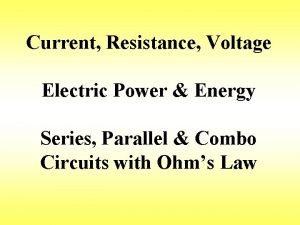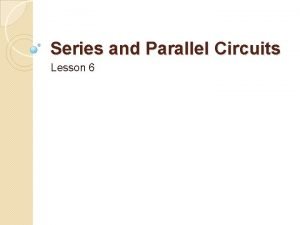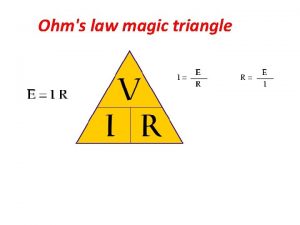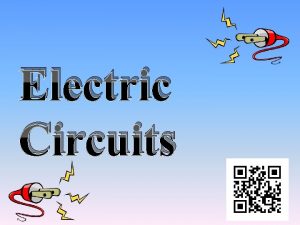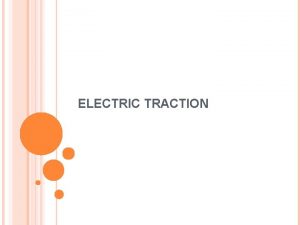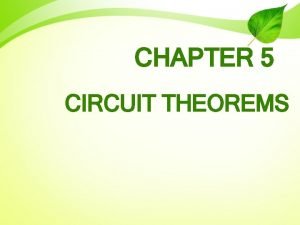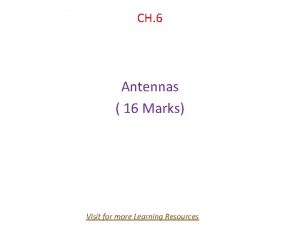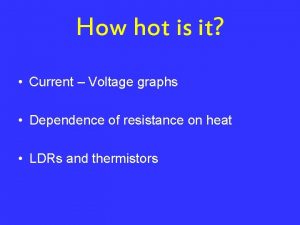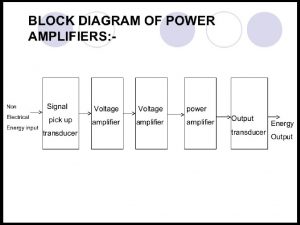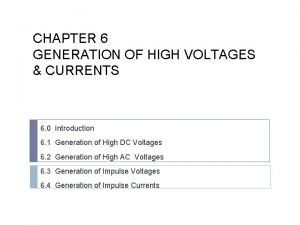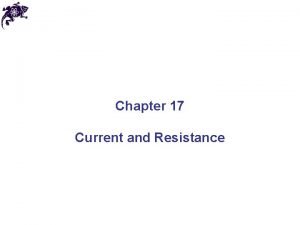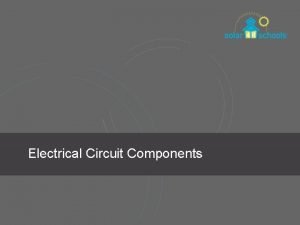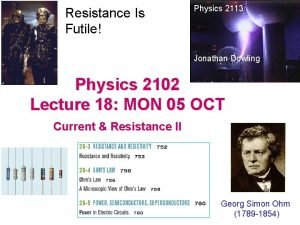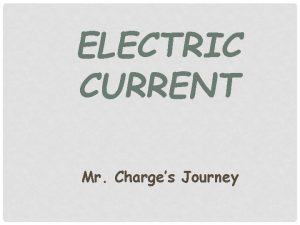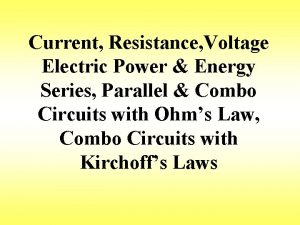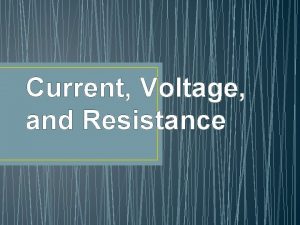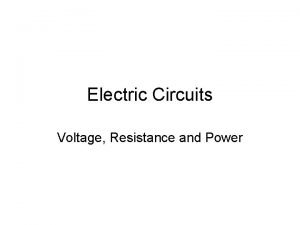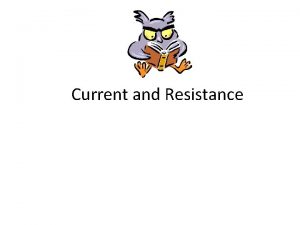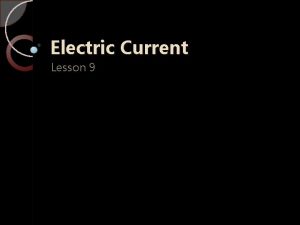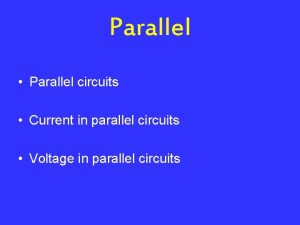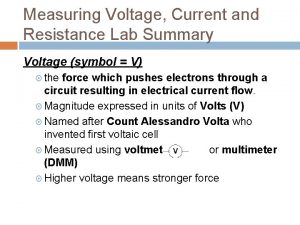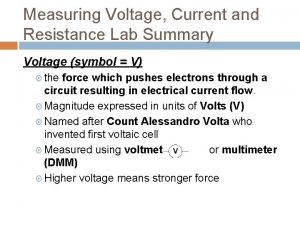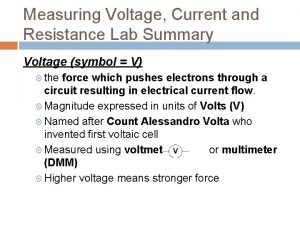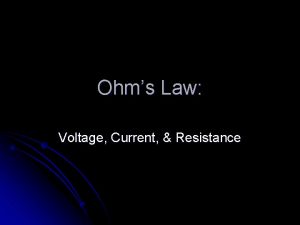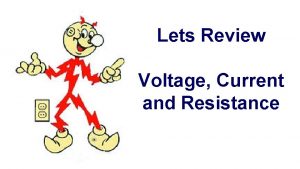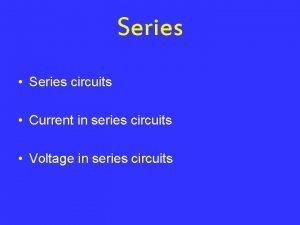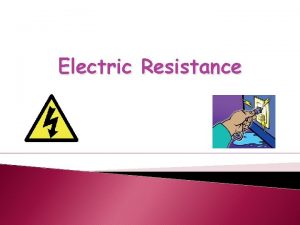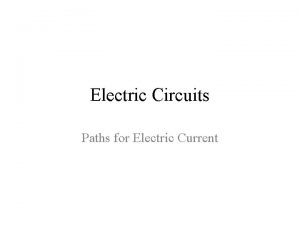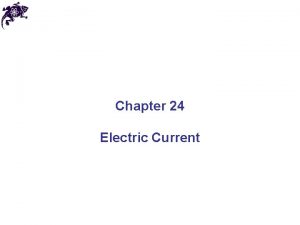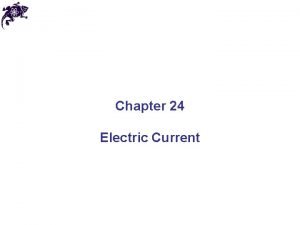Current Resistance Voltage Electric Power Energy Series Parallel


































- Slides: 34

Current, Resistance, Voltage Electric Power & Energy Series, Parallel & Combo Circuits with Ohm’s Law

Current (I) • The rate of flow of charges through a conductor • Needs a complete closed conducting path to flow • Measured with an “ammeter” in amps (A) named for Ampere – French scientist

Voltage (V) • Electric potential difference between 2 points on a conductor • Sometimes described as “electric pressure” that makes current flow • Supplies the energy of the circuit • Measured in Volts (V) using a voltmeter

Resistance (R) • The “electrical friction” encountered by the charges moving through a material. • Depends on – Material – Length – Temperature – Cross-sectional area of conductor • Measured in Ohms (Ω)

Ohm’s Law • A relationship between voltage, current, and resistance in an electric circuit • used to make calculations in all circuit problems • V = potential difference (voltage) in volts • I = electric current in amperes (amps , A) • R = resistance in ohms ( )

Series Circuits • Current can only travel through one path • Current is the same through all parts of the circuit. • The sum of the voltages of each component of the circuit must equal the battery. • The equivalent resistance of a series circuit is the sum of the individual resistances. R 1 V I R 3 R 2

Solving a Series Circuit Step 1: Find the equivalent (total) resistance of the circuit IT 6 V R 1=1 Ω R 2=2 Ω Step 2: Find the total current supplied by the battery Step 3: Find Voltage Drop across each resistor. Note: Voltage adds in series and voltage drops should add to the battery voltage, 3 V+3 V=6 V

Turn in WS

Electric Power (Watts) units using

Electric Energy • Electric energy can be measured in Joules (J) or Kilowatt hours ( k. Wh ) • for Joules use Power in watts and time in seconds • for k. Wh use Power in kilowatts and time in hours

Example Problem #1 An electric furnace is connected across a 117 V circuit. The furnace dissipates 3. 5 k. W of power in the form of heat. a) What is the resistance of the furnace? b) How much heat does the furnace produce in 5 min?

Example Problem #2 Your bedroom lights are four 60 W bulbs. a) If they are each hooked up to 120 V, how much current do they each draw? b) What is the resistance of each bulb? c) If the lights are on for 3 hours a day, how much energy (in k. Wh) do they consume in 30 days? d) If electricity costs $0. 12 per k. Wh, how much does it cost to operate the lights for a month?

Parallel Circuits • Current splits into “branches” so there is more than one path that current can take • Voltage is the same across each branch • Currents in each branch add to equal the total current through the battery V R 1 R 2 R 3

Solving a Parallel Circuit Step 1: Find the total resistance of the circuit. Step 3: Find the current through each resistor. Remember, voltage is the same on each branch. Step 2: Find the total current from the battery. Step 4: Check currents to see if the answers follow the pattern for current. R 2=6Ω 12 V R 1=12Ω R 3=4Ω The total of the branches should be equal to the sum of the individual branches.

Example problem A circuit has 3 resistors in parallel: 3 W, 3 W and 6 W attached to a 10 V battery. Draw the circuit, then find the voltage across and the current through each resistor.

REVIEW Picture Total Resistance Current Voltage with more resistorstotal resistance total current Series Parallel

Reading Resistors Color bands: digit, mulitpler, tolerance

Review Worksheet Omit 1 and 3 on the front. Answers online Due Tues – Parallel WS, Review WS

Solving a Parallel Circuit Step 1: Find the total resistance of the circuit. Step 3: Find the current through each resistor. Remember, voltage is the same on each branch. Step 2: Find the total current from the battery. Step 4: Check currents to see if the answers follow the pattern for current. R 2=2Ω 12 V R 1=1Ω R 3=3Ω The total of the branches should be equal to the sum of the individual branches.

Combo Circuits with Ohm’s Law What’s in series and what is in parallel? A 3Ω B 5Ω 15 V 1Ω 6Ω 4Ω 7Ω D 2Ω C 6Ω 4Ω B 3Ω It is often easier to answer this question if we redraw the circuit. Let’s label the junctions (where current splits or comes together) as reference points. 1Ω A 5Ω 15 V C 2Ω D 7Ω

Combo Circuits with Ohm’s Law Now…again…what’s in series and what’s in parallel? 6Ω 4Ω B 3Ω 1Ω A C 2Ω D 7Ω 5Ω 15 V The 6Ω and the 4Ω resistors are in series with each other, the branch they are on is parallel to the 1Ω resistor. The parallel branches between B & D are in series with the 2Ω resistor. The 5Ω resistor is on a branch that is parallel with the BC parallel group and its series 2Ω buddy. The total resistance between A & D is in series with the 3Ω and the 7Ω resistors.

Combo Circuits with Ohm’s Law Finding total (equivalent) resistance 6Ω 4Ω B 3Ω 1Ω A C 2Ω D 7Ω 5Ω 15 V To find RT work from the inside out. Start with the 6+4 = 10Ω series branch. So, 10Ω is in parallel with 1Ω between B&C… Then, RBC + 2Ω=2. 91Ω and this value is in parallel with the 5Ω branch, so… Finally RT = RAD +3 + 7 = 1. 84 + 3 + 7 RT = 11. 84Ω

Combo Circuits with Ohm’s Law Solving for current and voltage drops in each resistor RT = 11. 84Ω 6Ω 4Ω B C 1Ω 3Ω 2Ω D A 7Ω 5Ω IT=1. 27 A 15 V The total current IT goes through the 3Ω and the 7Ω and since those are in series, they must get their chunk of the 15 V input before we can know how much is left for the parallel. So… Then… So… Since parallel branches have the same current, that means the voltage across the 5Ω resistor V 5Ω=4. 84 V and the voltage across the parallel section between B&C plus the 2Ω is also 4. 84 V

Combo Circuits with Ohm’s Law Solving for current and voltage drops in each resistor (continued) 6Ω 4Ω C B 1Ω 3Ω 2Ω I 2Ω=0. 81 A A D I 5Ω=0. 46 A 7Ω 5Ω IT=1. 27 A Known values from previous slide. IT=1. 27 A 15 V To calculate the current through the 5Ω resistor… To calculate the top branch of the parallel circuit between points A & D we need to find the current and voltage for the series 2 Ω resistor. Since the current through the resistor plus the 0. 92 A for the bottom branch must equal 1. 3 A. So…

Combo Circuits with Ohm’s Law Solving for current and voltage drops in each resistor (continued) I 6Ω=I 4Ω =0. 068 A C B 6Ω 3Ω I 5Ω=0. 46 A 2Ω 4Ω 1Ω A Known values from previous slide. I 1Ω=0. 68 A I 2Ω=0. 81 A D 7Ω 5Ω IT=1. 27 A 15 V Next we need to calculate quantities for the parallel bunch between points B&C. The voltage that is left to operate this parallel bunch is the voltage for the 5Ω minus what is used by the series 2Ω resistor. The 1Ω resistor gets all of this voltage. IT=1. 27 A Finally we need to calculate the current through the 6Ω and 4Ω resistors and the voltage used by each. All we need now is the voltage drop across the 6Ω and 4Ω resistors. So… THE END!

Kirchoff’s Law of Loops ( or Voltages) treats complex circuits as if they were several series circuits stuck together. So…the rules of series circuit voltages allows us to write equations and solve the circuit. or ΣVinput = ΣVdrops Law of Nodes (or Currents) The total of the currents that enter a junction (or node) must be equal to the total of the currents that come out of the junction (or node). or ΣIin = ΣIout We use this law already in general when we add currents in the branches of a parallel circuit to get the total before it split into the branches.

Kirchoff’s Laws of Voltage writing the equations Draw current loops so that at least one Use Σ Vinput = Σ Vdrops loop passes through each resistor. for each current loop to Current loops must NOT have branches. R 1 R 4 R 2 V IA IB IC R 5 R 6 R 7 R 3 write these equations. Remember that current is a vector so if multiple currents pass through a resistor, the total is the vector sum of the currents assuming the current loop you are writing the equation for is positive. Loop A V= IA R 1+( IA- IB) R 2+ IA R 7 Loop B 0 = (IB- IA) R 2+( IB- IC)R 4+ IB R 3 Loop C 0 = (IC- IB) R 4+ ICR 5+ IC R 6

Kirchoff’s Law of Voltage putting numbers in the equations 3Ω 1. Draw current loops so that at least one loop passes through each resistor. Current loops must NOT have branches. 2. Write an equation for each loop. 3. Solve the system of equations for all of the unknowns using a matrix (next slide) 5Ω 15 V IA 1Ω IB IC 6Ω 4Ω 7Ω 2Ω Loop A 15 V = IA (3Ω)+( IA- IB) (5Ω) + IA (7Ω) 15 = 3 IA+5 IA-5 IB+7 IA 15 = 15 IA - 5 IB + 0 IC Loop B 0 = (IB- IA) (5Ω) +( IB- IC)(1Ω) + IB (2Ω) 0 = 5 IB – 5 IA +1 IB -1 IC+2 IB 0 = -5 IA + 9 IB - 1 IC Loop C 0 = (IC- IB) (1Ω) + IC (6Ω) + IC (4Ω) 0 = 1 IC-1 IB+6 IC +4 IC 0 = 0 IA -1 IB + 11 IC Note: you must have coefficients for each unknown (even if it is zero) in every current loop equation.

Kirchoff’s Law of Voltage setting up and solving the matrix for IA, IB, and IC Beginning with the system of equations we wrote on the previous slide, we need to express these in matrix form to solve 15 V for the 3 unknowns 15 = 15 IA - 5 IB + 0 IC 0 = -5 IA + 9 IB - 1 IC 0 = 0 IA -1 IB +11 IC IA 15 15 -5 0 -5 9 -1 * IB = 0 IC 0 0 -1 11 coefficients A unkowns answers * x = B Create matrix A and B in your calculator. (Matrx> >Edit, then choose A or B ) 3Ω 5Ω IA 1Ω IB IC 6Ω 4Ω 7Ω 2Ω In a normal algebra equation Ax=B, the solution is x = B/A, however matrix operations do not allow for division so instead, after you create the matrices, you will use them in the following operation. x=A-1 B. The answer will be in matrix form containing all of the unknowns in the order they were set up.

Kirchoff’s Laws of Voltage Interpreting the answers to the matrix problem 3Ω IA 15 15 -5 0 -5 9 -1 * IB = 0 IC 0 0 -1 11 coefficients A 15 V IA = IB IC IA 1Ω IB IC unkowns answers * x = B After performing the operation x=A-1 B, the calculator will give you a matrix answer (the number of decimal places will depend on the calculator settings) like below. 1. 23 0. 69 0. 063 5Ω So now we know that IA = 1. 23 A, IB=0. 69 A and IC = 0. 063 A Now what? 6Ω 4Ω 7Ω 2Ω Using these current loop values we can now evaluate current, voltage, and power through any resistor in the circuit. Example: for the 3Ω resistor, only IA passes through it so the I 3Ω = 1. 23 A, the voltage is V=IR=1. 23 A*3Ω=3. 69 V, and power, P=I 2 R= (1. 23)2*3Ω = 4. 54 W

Kirchoff’s Laws of Voltage But what if the resistor you ask me about is shared by two current loops? Yikes! 3Ω So now we IA know that 1. 23 IA = 1. 23 A, 0. 69 = IB 5Ω 1Ω 15 V IB=0. 69 A 0. 063 6Ω IC I I A B IC and IC = 0. 063 A 4Ω 7Ω 2Ω Let’s evaluate the 5Ω resistor: Since it is shared by current loops A and B, the current is the vector sum of the two. In this case IA & IB pass through the resistor in opposite directions so…I 5Ω = IA-IB=1. 23 A-0. 69 A=0. 54 A. The voltage drop is calculated V 5Ω=I 5ΩR=0. 54 A*5Ω=2. 7 V. The power dissapated is P=I 5Ω 2*R=(0. 54 A)2*5Ω=1. 46 W.

Kirchoff’s Law of Nodes 3Ω IT I 1 I 2 2Ω 2Ω 10 V IT I 2 1Ω 1Ω Node IT=I 1+I 2 The current entering one node is equal to the sum of the currents coming out

Voltmeter and Ammeter • Ammeter – measures current in amps or m. A – used in series • Voltmeter – measures voltage – used in parallel

Resistivity (ρ) • Property of material that resists the flow of charges (resistivity, ρ, in Ωm) • The inverse property of conductivity • Resistivity is temperature dependent…as temperature increases, then resistivity increases, and so resistance increases.
 Parallel circuit vs series circuit
Parallel circuit vs series circuit Finding total resistance in a series circuit
Finding total resistance in a series circuit Lesson 6 current voltage and resistance in a circuit
Lesson 6 current voltage and resistance in a circuit Triangle ohm
Triangle ohm Short circuit example
Short circuit example Fusao
Fusao Energy with voltage and current
Energy with voltage and current Series vs parallel diagram
Series vs parallel diagram Advantages of parallel circuits over series circuits
Advantages of parallel circuits over series circuits An ideal traction system should have
An ideal traction system should have Electric potential energy
Electric potential energy Medium voltage range
Medium voltage range Ac voltage controllers
Ac voltage controllers Difference between phase voltage and line voltage
Difference between phase voltage and line voltage Convert rms to peak
Convert rms to peak The objectives of earthing is
The objectives of earthing is Specific cake resistance and filter medium resistance
Specific cake resistance and filter medium resistance Ignoring friction air resistance and electrical resistance
Ignoring friction air resistance and electrical resistance Mig welding voltage chart
Mig welding voltage chart Condition for maximum power transfer theoram is
Condition for maximum power transfer theoram is Non resonant antenna
Non resonant antenna Current and voltage distribution in antenna
Current and voltage distribution in antenna Thermistor voltage current graph
Thermistor voltage current graph Difference between voltage amplifier and power amplifier
Difference between voltage amplifier and power amplifier Generation of high voltage and current
Generation of high voltage and current Landline telemetry system
Landline telemetry system Potential energy formula
Potential energy formula Electric field stress in high voltage engineering
Electric field stress in high voltage engineering 17-1 current and resistance answers
17-1 current and resistance answers Why resistance opposes the flow of current
Why resistance opposes the flow of current Current potential difference and resistance
Current potential difference and resistance Young and freedman
Young and freedman An electric lamp whose resistance is 20 ohm
An electric lamp whose resistance is 20 ohm Resistivity resistance formula
Resistivity resistance formula A portable electric heater has a resistance of 8 ohms
A portable electric heater has a resistance of 8 ohms

